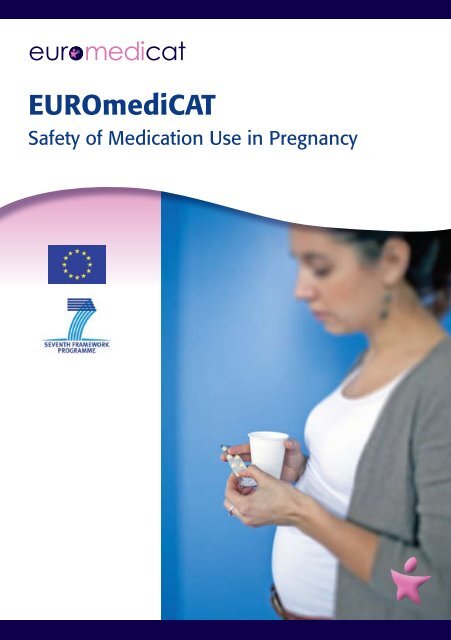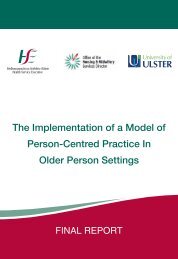EUROmediCAT
EUROmediCAT
EUROmediCAT
Create successful ePaper yourself
Turn your PDF publications into a flip-book with our unique Google optimized e-Paper software.
<strong>EUROmediCAT</strong><br />
Safety of Medication Use in Pregnancy
Background<br />
• Drug use during pregnancy is common - 40-90% women use at least 1 drug<br />
in pregnancy.<br />
• Safety in pregnancy for many drugs has not been established at the time<br />
of licensing because 1) animal studies are seriously limited in their ability to predict<br />
human teratogenesis* and 2) pregnant women are excluded from pre-marketing<br />
clinical trials in humans.<br />
• Teratogenic effects in humans cannot be predicted reliably from the class of a drug or<br />
from what is known about its pharmacology and toxicology.<br />
• Therefore, we learn about teratogenic effects in humans only after marketing,<br />
when the drugs have been used by pregnant women.<br />
• Many drugs are subject to contraindications or special warnings because<br />
investigations in pregnancy are insufficient for possible harms to be identified.<br />
Aims and objectives<br />
In <strong>EUROmediCAT</strong> we aim to build a European system for reproductive safety evaluation:<br />
• to identify systematically and comprehensively the possible adverse effects<br />
in pregnancy of drugs at the earliest possible stage post marketing<br />
• to monitor and evaluate European safety measures.<br />
The specific objectives of <strong>EUROmediCAT</strong> are:<br />
• To develop and test an efficient system for safety evaluation of drugs during<br />
pregnancy. This is based on an existing network of congenital anomaly (CA) registers<br />
in Europe (EUROCAT, www.eurocat-network.eu) combined with existing healthcare<br />
databases.<br />
• To quantify the risk of CA** related to four drug classes:<br />
o new antiepileptics,<br />
o insulin analogues,<br />
o anti-asthmatics,<br />
o antidepressants, in particular the selective serotonin re-uptake inhibitors<br />
• To develop a framework for evaluation of the efficacy of pregnancy-related drug safety<br />
measures including:<br />
o drug utilisation studies<br />
o monitoring the effectiveness of pregnancy prevention programmes<br />
o a scoping study of the role of internet access to drugs and related safety<br />
information by pregnant women<br />
<strong>EUROmediCAT</strong> builds on:<br />
• the EUROCAT database, enriched with detailed data on prescribing and dispensing<br />
drugs in pregnancy,<br />
• the EUROCAT network, enriched with a broader network of expertise on drug safety.<br />
* Teratogenesis is the impaired development of fetal organs, leading to structural or<br />
functional abnormalities<br />
** CA (congenital abnormality, congenital malformation, birth defect) is a condition<br />
which is present at or before birth which varies from the standard presentation. The<br />
definition may be restricted to structural abnormalities and those resulting from<br />
imperfect development of the embryo.<br />
2
Advantages of <strong>EUROmediCAT</strong> for postmarketing surveillance of medicines<br />
• Many countries participate in <strong>EUROmediCAT</strong>. The resulting diversity in prescribing<br />
practice allows us to:<br />
o dissociate drug-related effects from disease<br />
o generalise and disseminate our findings across the European Union,<br />
impacting on practice<br />
• <strong>EUROmediCAT</strong> will cover at least 3.7 million births from 1995 to2010. This is essential<br />
for the study of rare outcomes (CA) and rare drug exposures.<br />
• The data reflect the whole population. Information comes from all women and all<br />
pregnancies, including all types of CA and irrespective of medication use in<br />
pregnancy.<br />
• The size of the database on babies/fetuses with anomalies and the detail and<br />
standardisation of the description and coding of anomalies allows associations<br />
between specific types of anomalies and specific drugs to be studied<br />
• EUROCAT also includes data on terminations of pregnancy for fetal anomaly (TOPFA)<br />
following prenatal diagnosis. TOPFA inclusion is essential as the proportion of TOPFA<br />
is 14% (average for <strong>EUROmediCAT</strong> registries 2000-2007), rising to 40-80% for some<br />
specific anomalies such as anencephaly, spina bifida, hydrocephaly, hypoplastic<br />
left heart, omphalocele and bilateral renal agenesis. Demographic and other factors<br />
affect the proportion of pregnancies ending in TOPFA. Studies not accounting for<br />
these variables are likely to be biased.<br />
Workpackage overview<br />
WP 1<br />
Coordination and<br />
management<br />
WP 2<br />
Central database<br />
and Software<br />
development<br />
WP 3<br />
Prescription data<br />
linkage<br />
WP 6<br />
Monitoring of safety<br />
recommendations:<br />
drug utilisation<br />
studies<br />
WP 7<br />
Internet use and<br />
drug safety<br />
WP 4<br />
Antiepiletic drugs<br />
and Insuline<br />
Analogues<br />
WP 5<br />
SSRIs and<br />
Anti-asthmatics<br />
WP 8<br />
Dissemination Workshop<br />
3
<strong>EUROmediCAT</strong> Details<br />
Financial support for the study is provided by the European Union under the 7th Framework<br />
Program (grant agreement HEALTH-F5-2011-260598).<br />
Start date: 1 March 2011. Duration: 48 months.<br />
Coordinator<br />
Prof. Helen Dolk, University of Ulster, UK<br />
Tel: +44 28 90368540, Email: h.dolk@ulster.ac.uk<br />
Scientific coordinators<br />
Dr. Marian Bakker, University Medical Center Groningen, The Netherlands<br />
Tel: +31 50 3617115, Email: m.k.bakker@umcg.nl<br />
Prof Lolkje de Jong-van den Berg, University of Groningen, The Netherlands<br />
Tel: +31 50 3633330, email: l.t.w.de.jong-van.den.berg@rug.nl<br />
President of the <strong>EUROmediCAT</strong> Steering Group<br />
Dr. Awi Wiesel, University Mainz, Germany<br />
Tel: +49 6131 172773, email: wiesel@kinder.klinik.uni-mainz.de<br />
Further information can be found at www.euromedicat.eu<br />
<strong>EUROmediCAT</strong> Partners<br />
Hospital Lillebaelt, Denmark<br />
Dr. Ester Garne<br />
Institute of Clinical Physiology-National<br />
Research Council, Italy<br />
Dr. Anna Pierini<br />
Poznan University of Medical Science,<br />
Poland<br />
Prof. Anna Latos Bielenska<br />
University Medical Center Groningen, The<br />
Netherlands<br />
Dr. Marian Bakker<br />
University of Groningen, The Netherlands<br />
Prof. Lolkje de Jong-van den Berg<br />
Barts and the London School of Medicine<br />
and Dentistry, UK<br />
Prof. Joan Morris<br />
Swansea University, UK<br />
Dr. Sue Jordan<br />
University of Bath, UK<br />
Prof. Corinne de Vries<br />
University of Ulster, UK<br />
Prof. Helen Dolk<br />
Maria Loane<br />
Prof. Marlene Sinclair<br />
4<br />
Subcontractor/third party<br />
birth defects registries<br />
Antwerp, Belgium<br />
Cork & Kerry, Ireland<br />
Emilia Romagna, Italy<br />
Mainz, Germany<br />
Malta<br />
Norway<br />
Paris, France<br />
Vaud, Switzerland<br />
Zagreb, Croatia
















